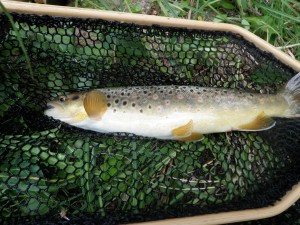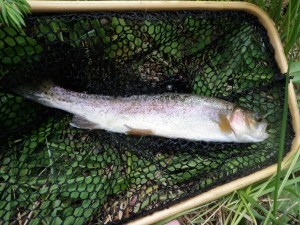Time: 3:00PM – 6:30PM
Location: Reservoir to just beyond road crossing
Fish Landed: 14/2010 Photo Album
Fooses Creek 07/17
It was forecast to be another hot day, so I decided to hike the Colorado Trail with Jane to the Blanks cabin in the morning, and then fish in a small headwater stream in mid to late afternoon. Jane and I got off to a nice early start and actually went beyond the Blanks cabin to the turn off to hike to the summit of Mt. Shavano. It was quite an accomplishment two months after hip surgery.
When we returned to camp we put up the canopy as some dark clouds were building in the west and then we had lunch and lounged a bit and read. I gathered my fishing things and left the campground at around 2:30 and drove to Fooses Creek. Fooses Creek is a small tributary to the Arkansas River that begins near the Continental Divide near Monarch Pass. I’d fished it once before many years ago. It was a short drive from the campground to Route 50 then up the highway a few miles then a mile or two on a dirt road south of 50.
The stream flows into a small reservoir, and when I crested the hill and saw the reservoir, there was no where to park as the lake was surrounded by fishermen. I later learned that the lake had been recently stocked. I performed a three point turn and parked in a lot below the reservoir. After putting on my fishing gear, I climbed back up the hill to the lake. The sky was quite cloudy and a welcome relief from the last week of bright sunny days. I spotted quite a few fish rising in the lake, but moved on to the inlet as I’d targeted the stream. When I reached the inlet, I could see a fish rising and taking something right in the current where the stream entered the lake. I tied on an olive body deer hair caddis, and quickly hooked up on a fish, but it got off just as quickly. Next I spotted a rise where the stream dropped off into deeper water in the lake. A longer cast brought a fish to my fly, and I had another momentary hook up.
I reminded myself that my goal was to fish the stream, and retrieved my fly and moved on. At this point I ran into a couple fishermen coming down the road to the lake with fly rods. I asked if they’d disturbed the stream, and they asked me if I fished it before. I replied that I had, and they said, “Then you know there aren’t that many fishable spots, so we didn’t disturb much.” I decided to press on.
Fooses Creek is quite narrow, probably five feet wide in most places. It tumbles down at a fairly steep gradient and there is much streamside vegetation, rocks and debris to hinder a fisherman. Some streams present a challenge of reading the water and finding fish and some offer the challenge of identifying insects and selecting the correct fly. The challenge of Fooses Creek is how to get a fly over fish without spooking the target. I used normal casts, bow and arrow casts, and dapping over the next 3.5 hours to land 12 trout. I used a Chernobyl Ant the whole time as it was very buoyant and I had minimal space for false casting to dry a fly. I had a blast. As I moved to each spot I had to determine how to position myself and then how to execute a cast in tight quarters. Once again, the small fish dropped off the fly as it was too big for their mouths. The fish I did land were typically 6-10 inches, but colorful and feisty. In many cases I spotted the trout and carefully presented the Chernobyl. In other cases, the take was a complete surprise. I caught numerous fish with the fly within two feet of the top of my rod as I reached the long rod above and beyond a possible trout lie, then brought the rod back at the same speed as the current. Of the twelve trout I landed from the stream, 11 were browns and 1 was a rainbow.
I crossed the dirt road and fished the stream on the southeast side of the road a short distance. The clouds grew darker, and I could hear thunder and see occasional lightening.
I decided to leave the stream and hike back to the lake with a half hour or so of time remaining before I needed to return to Jane at the campground to help prepare dinner. Quite a few additional stocker stalkers had arrived and pretty much owned the inlet area of the lake, so I moved to the north end along the road. I tied on the olive caddis and began sending out long casts to where I’d spotted rises. I learned that I needed to allow the fly to sit for what seemed like an interminable length of time, and a fish would eventually rise to it. I had quite a few refusals, but did hook up and land two stocker rainbows. The second rainbow actually nailed the fly as I stripped it slowly but fast enough to create a small wake. I thought this was the solution to catching more fish, but it was very inconsistent.
The sky darkened considerably and while fishing the lake it showered several times. I put on my raincoat and fished on. After a half hour or so of lake casting, I called it quits and headed back to the campground.






